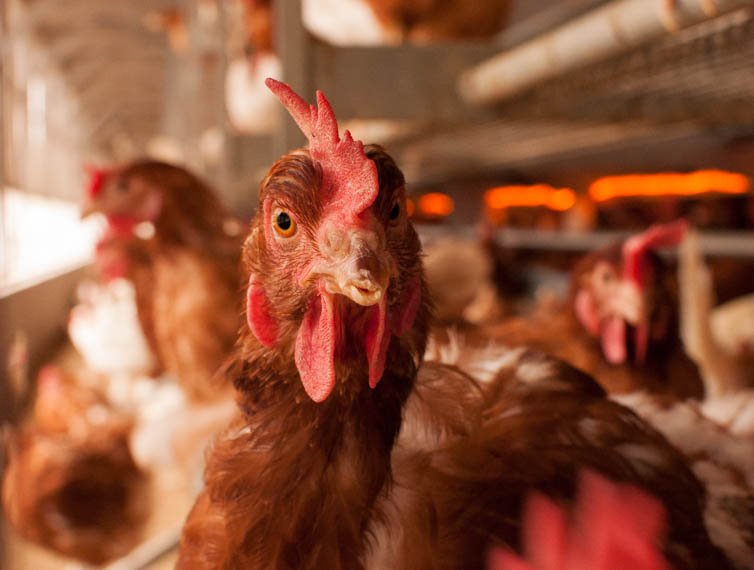“The nest boxes are at a slight angle,” explains Hilliker. “So after their lay their eggs, they’ll roll out the back, and there’s a conveyer belt behind it that we turn on to bring the eggs out.”
Hilliker made the changes to comply with the requirements of California’s Proposition 2 , which voters passed in 2008. The initiative, backed by animal rights activists, was designed to push farmers away from traditional battery cages, where hens were often packed in so tightly they couldn’t really move. Check out this musical ad from the Yes on Prop 2 campaign.
The measure, which voters passed by more than 63 percent, required egg-laying chickens to have enough room to lie down, stand up, sit down, turn around and fully extend their wings by Jan. 1, 2015.
Some producers, like Hilliker, are building brand-new facilities. Others are simply putting fewer hens into traditional battery cages and removing the partitions to allow more space.
What’s not clear is just who will be coming around to make sure farmers like Hilliker are complying with everything Prop. 2 spelled out.
“Nobody wants to touch it,” says Hilliker.
The California Department of Food and Agriculture, which generally inspects egg facilities, says it’s not in charge of enforcing Prop 2. Local law enforcement is, because the measure makes it a misdemeanor to cram hens into small cages. (That includes fines and potential jail time for farmers who break the law.)
But when I called sheriff’s offices in some of California’s top egg-producing counties, they were a little hesitant. Some of them even chuckled when I asked if they planned to visit henhouses with a tape measure.
“I must say, unless there’s some directive that will come down, or the law binds us to that, there is no plan for us to go measure every henhouse in Merced County,” says Sgt. Delray Shelton, from the Merced County Sheriff’s Department.
But, he added, “the law in general, whether it’s applicable to chickens and hens or people, is important to us, so we will do our very best.”
Shelton says county animal control officers will be the ones to cite farmers if they stumble across a henhouse where the birds seem to be squeezed into cages that are too small to comply with Prop. 2.
Jan Glick, of the California Animal Control Directors Association, confirms that’s the case statewide. Although animal control usually deals with things like rabies and bite investigations involving dogs and cats, they’re willing to take on hens.
“So if we got a complaint that there were animals producing eggs for sale that did not meet the requirements under the law, we would investigate,” says Glick, who's based at the Santa Barbara County animal shelter.
Notice she says IF they get a complaint. Local animal control officers are too busy to actually go around proactively inspecting egg farms.
So who is watching the henhouse? State farm inspectors will be checking out how much space the birds have, but under a different regulation that also took effect this week. That rule is focused on food safety and salmonella prevention.
Are you confused yet? This stuff is confusing. And the state’s veterinarian, Dr. Annette Jones, admits it.
“You know, I apologize to you and the public,” says Jones, who is with the California Department of Food and Agriculture. She says she understands consumers may be baffled by all these different egg rules.
“That’s sometimes the nature of our propositions,” she says.
That’s a sentiment echoed by Bill Dombrowski, who heads the California Retailers Association, which has been working with both in-state and out-of-state egg suppliers to make sure they’re ready for the new rules.
“Part of the problem with Prop. 2, and propositions and initiatives in general, is that they’re not written to work,” says Dombrowksi. “Everybody’s confused.”
That includes consumers. Egg cartons won’t be labeled Prop. 2 compliant. But starting this week, you will see new labels that say "California Shell Egg Food Safety Compliant." That doesn’t necessarily mean the eggs meet Prop. 2 standards, but they do meet similar space requirements for the birds.
But animal rights activists say the only way to enforce Prop. 2 is if consumers who voted for the measure now vote with their wallets, and choose eggs where they know the birds didn’t spend their time in a cage.
“If Prop. 2 is going to mean something, then food retailers in the state of California need to get on board with cage free,” says Wayne Pacelle, who directs the Humane Society of the United States. “It’s very simple. Animals built to move should be allowed to move.”
Cage free. That’s like the setup Frank Hilliker has. That’s not to be mistaken with free range, which is another scenario where the birds get some time outside.
So the big question is: How will all these choices and rules affect the price of your breakfast? Some economists are projecting a spike in egg prices -- although those prices have already been rising for other reasons: rising demand for eggs in Mexico and more fast-food restaurants serving egg-based breakfasts.

